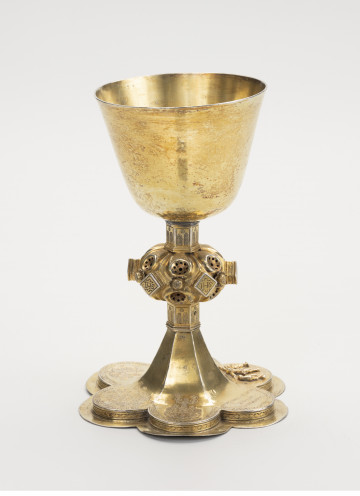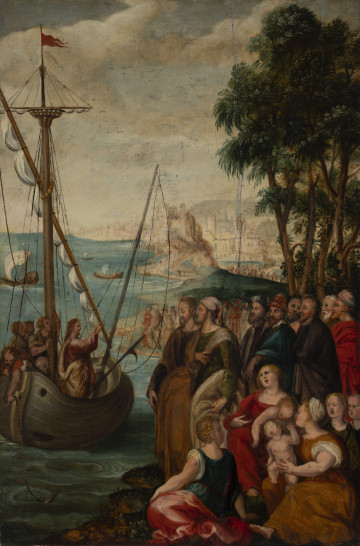
Communion chalice
1598
National Museum in Szczecin
Part of the collection: Goldsmith craftsmanship
With the introduction of the Reformation in the Duchy of Pomerania in 1534, some liturgical equipment such as monstrances, incensories, reliquaries and pax were no longer used. In Lutheran churches, only the vessels associated with the administration of communion under both kinds were needed: chalices and jugs were used to serve the communion wine, and patens or plates and pyx for the communion. In the first decades after the introduction of the Reformation, old liturgical silverware was used in Pomerania, and the earliest known newly-found vessels, mainly chalices, only date from the mid-16th century.
The present pyx has a simple cylindrical shape and modest engraved decoration, which is characteristic of early Lutheran vessels of this type. It was originally closed with an arched lid, with a wide decorative rim and finial, probably figural. Later, the forms of the tins used to hold the hosts became more varied: polygonal, oval, rectangular and also cup-shaped, and the decoration was dominated by chamfered decoration.
The top of the pyx is engraved with the foundation inscription and a coat of arms with an emblem in the form of a sun with a human face surrounded by flaming rays. This motif is repeated in the jewel, between the buffalo horns. The coat of arms belonged to the Szczecin merchant Gregor Mundinus, who in 1615 founded the vessel for the church of St James in Szczecin. His wife was Elisabetha von Düringshofen, a native of Poznań (alternate spelling of the surname: Diringshofen). Their son, the well-known Szczecin theologian Kaspar Gottfried Mundinus (1633-1671), was archdeacon at St Mary's Church and professor of Hebrew at the Carolinum Gymnasium in Szczecin.
Monika Frankowska-Makała
Author / creator
Object type
can (container), liturgical objects
Technique
forging, engraving, fine detail finishing, gilding
Material
silver
Origin / acquisition method
purchase
Creation time / dating
Creation / finding place
Owner
Muzeum Narodowe w Szczecinie
Identification number
Location / status

1598
National Museum in Szczecin

circa 1577
National Museum in Szczecin

3. ćwierć XVI wieku
National Museum in Szczecin
DISCOVER this TOPIC
Museum of King Jan III's Palace at Wilanów
DISCOVER this PATH
Educational path